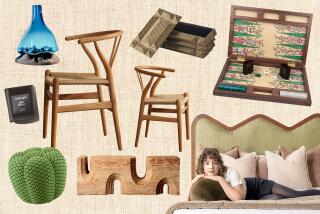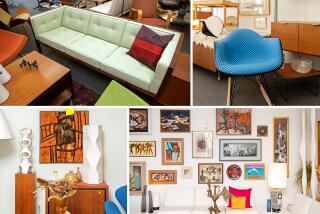FURNISHINGS : Armoires Shed Their Armor to Shelter Today’s Electronic Toys : The massive wardrobes these days store TVs, compact disc players, VCRs and videotapes. And they’re turning up increasingly in children’s rooms.
For hundreds of years, the armoire remained an anchor in the bedroom. A family heirloom handed down through the generations, the movable wardrobe for clothes was derived from a closet whose original purpose was to store armor.
Early armoires were necessarily massive in size to accommodate the iron suits. The door panels were decorated with elaborate iron hinges and locks, while later armoires--particularly in France during the Renaissance--featured intricate hand-carved designs.
Today’s armoires are either traditional or contemporary in design. Their use, however, has become extremely modern.
Instead of armor or clothing, the current trend has armoires providing storage for TVs, compact disc players, VCRs and videotapes.
Consequently, the wooden wardrobes of the 1990s look just as at home in the living room or den as the bedroom--maybe even more so.
“At the Antique Guild, 80% of our armoires are sold as entertainment furniture, and only about 20% is the standard, traditional kind of armoire,” said Mark Briscoe, the six-outlet chain’s buyer and manager of the Santa Ana store.
“Many of the new armoires can serve dual functions,” he said. “The drawers can store clothes just as easily as CDs, albums or videotapes. A clothing bar on top also could enable the armoire to serve two functions. These are most popular.”
The Antique Guild retails both antique furniture and antique reproductions. According to Briscoe, older, investment-quality armoires are becoming increasingly difficult to find. Armoires built 50 to 100 years ago can sell for as little as $700 or as much as $10,000, depending on the condition of the piece and the intricacy of the carving. Even at the high end, Briscoe said, consumers are not afraid to convert the traditional armoire to an entertainment center.
“It becomes a unique piece of furniture,” he said. “People on the fast track, yuppies and such, know their neighbors aren’t going to find the same thing. And having an armoire provides a traditional base. It makes a great statement, whether it’s in the bedroom, living room or family room.”
Most antique reproductions at the Antique Guild, priced from $1,000 to $4,000 or so, don’t need to be converted.
Most are created as entertainment centers, their restructured interiors a direct result of technological advancements in electronics.
As TV sets got larger and VCRs gained in popularity, furniture manufacturers began to capitalize on the new requirements for their storage. The trend has been gradual, but it has come on strong the past three or four years.
“The furniture industry that’s involved in the entertainment end of the business has definitely followed the electronics industry,” Briscoe said. “If someone buys a 30-inch TV, that person is going to want a nice place to put it.
“By making armoires that can handle that size, and some that are even bigger, the industry has helped drive the business. By following suit, the industry created its own demand.”
Dale Pulver, chief executive officer of the Corona-based Mr. Bear’s Furniture chain, said his company’s seven outlets--including three in Orange County--are selling an increasing number of armoire entertainment centers.
Mr. Bear’s began 13 years ago as a store specializing in unfinished furniture. Even then, he said, very few armoires he sold were bought for hanging clothes. Rather, it was the many drawers that his customers found appealing.
“But because of the cost, the use of armoires began to change,” Pulver said. “They’re basically made by two primary kinds of suppliers: makers of bedroom furniture or entertainment centers.”
His outlets stock about six styles, half of them old-fashioned pieces still designed for bedroom use, the other half specially customized for entertainment purposes. None, however, is built just to hold clothes.
“Even if people buy them for the bedroom,” Pulver said, “they use some of the drawers to store games and puzzles. And because of that, armoires are often centerpieces of family rooms.”
Unlike either the Antique Guild or Mr. Bear’s Furniture, Barn Furniture Marts manufactures about 80% of the furniture it sells.
The Santa Ana store, like the other five in the Barn chain, offers 15 armoire models. Of these, 10 are entertainment centers.
“We started selling them about 10 years ago,” said Leon Tuberman, vice president of the chain his parents founded in 1945. “We took out the bar and shelves and just put in drawers. It’s been a very popular item.”
Tuberman estimated that his outlets sell 2,000 entertainment centers a month, 200 of which are armoires.
He has an armoire entertainment center in his own bedroom, he said, but he does not keep his TV on a shelf hidden behind a door. Instead, he keeps his on top of the armoire.
“A lot of people watch television in their bedrooms, and they want the TV set to be higher,” Tuberman said. “With an armoire that has a flat top, like mine, it’s possible to get the TV even higher up in the air. That makes it more comfortable to watch. It’s almost like a TV in a hospital room--it’s out of the way, and you can lie down in comfort to watch.”
The Barn introduces four to five pieces of furniture annually in its entertainment center group, Tuberman said, and armoires are part of that ongoing development. At the same time, each of the Barn’s bedroom sets includes an armoire as a focal piece.
“We’ve found that armoires are getting bigger, basically because television sets are getting bigger,” he said. “We’re also finding a migration of the armoire from the living room to the bedroom.
Also, he added, armoires are finding their way into children’s rooms. The reason? Natural progression.
“As families buy new, larger TVs for the living room, they usually put their old set in their bedroom,” Tuberman said. “Then, they’ll move their bedroom set into their kid’s room.
“Because of the ‘boob tube’ syndrome, it used to be unacceptable to have a television in a child’s room. But that’s not unusual any more.”
As a consequence, several of the Barn’s bedroom sets designed for children feature armoires.
What happens next in the evolution of the armoire is anyone’s guess.
More to Read
Inside the business of entertainment
The Wide Shot brings you news, analysis and insights on everything from streaming wars to production — and what it all means for the future.
You may occasionally receive promotional content from the Los Angeles Times.










